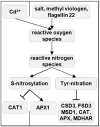Signaling Toward Reactive Oxygen Species-Scavenging Enzymes in Plants
- PMID: 33597960
- PMCID: PMC7882706
- DOI: 10.3389/fpls.2020.618835
Signaling Toward Reactive Oxygen Species-Scavenging Enzymes in Plants
Abstract
Reactive oxygen species (ROS) are signaling molecules essential for plant responses to abiotic and biotic stimuli as well as for multiple developmental processes. They are produced as byproducts of aerobic metabolism and are affected by adverse environmental conditions. The ROS content is controlled on the side of their production but also by scavenging machinery. Antioxidant enzymes represent a major ROS-scavenging force and are crucial for stress tolerance in plants. Enzymatic antioxidant defense occurs as a series of redox reactions for ROS elimination. Therefore, the deregulation of the antioxidant machinery may lead to the overaccumulation of ROS in plants, with negative consequences both in terms of plant development and resistance to environmental challenges. The transcriptional activation of antioxidant enzymes accompanies the long-term exposure of plants to unfavorable environmental conditions. Fast ROS production requires the immediate mobilization of the antioxidant defense system, which may occur via retrograde signaling, redox-based modifications, and the phosphorylation of ROS detoxifying enzymes. This review aimed to summarize the current knowledge on signaling processes regulating the enzymatic antioxidant capacity of plants.
Keywords: antioxidant enzymes; calcium; mitogen-activated protein kinases; oxidative stress; plants; reactive oxygen species; signaling; stress.
Copyright © 2021 Dvořák, Krasylenko, Zeiner, Šamaj and Takáč.
Conflict of interest statement
The authors declare that the research was conducted in the absence of any commercial or financial relationships that could be construed as a potential conflict of interest.
Figures






Similar articles
-
Heavy-metal-induced reactive oxygen species: phytotoxicity and physicochemical changes in plants.Rev Environ Contam Toxicol. 2014;232:1-44. doi: 10.1007/978-3-319-06746-9_1. Rev Environ Contam Toxicol. 2014. PMID: 24984833 Review.
-
ROS Regulation During Abiotic Stress Responses in Crop Plants.Front Plant Sci. 2015 Dec 8;6:1092. doi: 10.3389/fpls.2015.01092. eCollection 2015. Front Plant Sci. 2015. PMID: 26697045 Free PMC article. Review.
-
Roles of enzymatic and nonenzymatic antioxidants in plants during abiotic stress.Crit Rev Biotechnol. 2010 Sep;30(3):161-75. doi: 10.3109/07388550903524243. Crit Rev Biotechnol. 2010. PMID: 20214435 Review.
-
Reactive Oxygen Species and Antioxidant Defense in Plants under Abiotic Stress: Revisiting the Crucial Role of a Universal Defense Regulator.Antioxidants (Basel). 2020 Jul 29;9(8):681. doi: 10.3390/antiox9080681. Antioxidants (Basel). 2020. PMID: 32751256 Free PMC article. Review.
-
Friend or foe? Reactive oxygen species production, scavenging and signaling in plant response to environmental stresses.Free Radic Biol Med. 2018 Jul;122:4-20. doi: 10.1016/j.freeradbiomed.2018.01.011. Epub 2018 Jan 10. Free Radic Biol Med. 2018. PMID: 29331649 Review.
Cited by
-
Sandbur Drought Tolerance Reflects Phenotypic Plasticity Based on the Accumulation of Sugars, Lipids, and Flavonoid Intermediates and the Scavenging of Reactive Oxygen Species in the Root.Int J Mol Sci. 2021 Nov 23;22(23):12615. doi: 10.3390/ijms222312615. Int J Mol Sci. 2021. PMID: 34884421 Free PMC article.
-
Assessment of ecotoxicological effects of Fojo coal mine waste elutriate in aquatic species (Douro Coalfield, North Portugal).Front Toxicol. 2024 Feb 23;6:1334169. doi: 10.3389/ftox.2024.1334169. eCollection 2024. Front Toxicol. 2024. PMID: 38465195 Free PMC article.
-
Gm6PGDH1, a Cytosolic 6-Phosphogluconate Dehydrogenase, Enhanced Tolerance to Phosphate Starvation by Improving Root System Development and Modifying the Antioxidant System in Soybean.Front Plant Sci. 2021 Aug 13;12:704983. doi: 10.3389/fpls.2021.704983. eCollection 2021. Front Plant Sci. 2021. PMID: 34484268 Free PMC article.
-
Comparative physiological and transcriptomic analysis of two salt-tolerant soybean germplasms response to low phosphorus stress: role of phosphorus uptake and antioxidant capacity.BMC Plant Biol. 2023 Dec 20;23(1):662. doi: 10.1186/s12870-023-04677-y. BMC Plant Biol. 2023. PMID: 38124037 Free PMC article.
-
Vineyard light manipulation and silicon enhance ethylene-induced anthocyanin accumulation in red table grapes.Front Plant Sci. 2023 Jan 27;14:1060377. doi: 10.3389/fpls.2023.1060377. eCollection 2023. Front Plant Sci. 2023. PMID: 36778682 Free PMC article.
References
-
- Ahmad A., Khan W. U., Shah A. A., Yasin N. A., Naz S., Ali A., et al. . (2020). Synergistic effects of nitric oxide and silicon on promoting plant growth, oxidative stress tolerance and reduction of arsenic uptake in Brassica juncea. Chemosphere 262:128384. 10.1016/j.chemosphere.2020.128384 - DOI - PubMed
Publication types
LinkOut - more resources
Full Text Sources
Other Literature Sources

